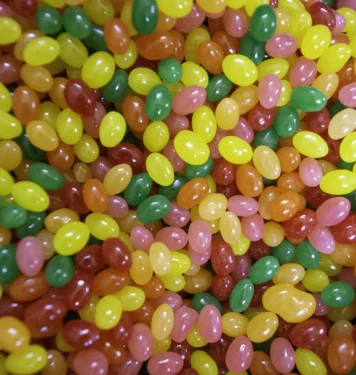Jelly beans are small, bean-shaped candies that come in a variety of colors and flavors. They are often associated with Easter, but they are available year-round in many countries. While some may assume that jelly beans are vegan, as they don’t contain any obvious animal products like milk or eggs, it’s important to look deeper into the ingredients and manufacturing process of jelly beans to determine whether or not they are suitable for a vegan lifestyle.
What are jelly beans?
Jelly beans were first introduced in the late 1800s in the United States. They are made by pouring sugar, corn syrup, and other ingredients into molds to create small, bean-shaped candies. They are then coated with a thin layer of hard candy to create a shiny, colorful exterior.
Ingredients in jelly beans
The ingredients in jelly beans can vary depending on the brand and flavor. However, the main ingredients typically include sugar, corn syrup, modified food starch, and flavorings. Some jelly beans may also contain other ingredients like citric acid, malic acid, and sodium citrate.
Gelatin and its vegan alternatives
One of the main ingredients to watch out for in jelly beans is gelatin. Gelatin is a protein made from animal collagen that is commonly used as a gelling agent in many foods, including candy. Gelatin is derived from animal bones and skin, making it unsuitable for those following a vegan lifestyle.
Fortunately, there are vegan alternatives to gelatin that can be used in jelly beans. One such alternative is agar-agar, which is made from seaweed and can be used to create a similar texture to gelatin. Other vegan alternatives to gelatin include carrageenan and pectin.
Artificial coloring in jelly beans
Many jelly beans are brightly colored, which can make them appealing to children and adults alike. However, some of these colors are derived from artificial dyes that may not be vegan-friendly. For example, some red dyes are made from cochineal, a red pigment derived from insects.
Fortunately, many jelly bean manufacturers are starting to use natural food dyes instead of artificial ones. These natural dyes are derived from fruits and vegetables, making them suitable for vegans.
Confectioner’s glaze in jelly beans
Confectioner’s glaze is a common ingredient in many types of candy, including jelly beans. It is made from the secretions of the female lac beetle and is used as a coating to make candies shiny and glossy. While confectioner’s glaze is not a direct animal product, it is derived from insects, which may make it unsuitable for vegans.
Manufacturing process of jelly beans
The manufacturing process of jelly beans typically involves mixing the ingredients together, pouring them into molds, and allowing them to cool and harden. Once the jelly beans are formed, they are coated with a thin layer of hard candy to create a shiny exterior. While the manufacturing process itself may not necessarily make jelly beans non-vegan, it’s important to consider the conditions under which they are made. For example, some jelly bean manufacturers may use non-vegan equipment or may share equipment with non-vegan products, which could result in cross-contamination.
Different types of jelly beans
There are many different types of jelly beans available in the market, each with their own unique flavors and ingredients. Some jelly beans may contain gelatin, while others may be free from animal products altogether. It’s important to read the ingredient list carefully to determine whether or not a particular brand or flavor of jelly beans is vegan.
Vegan jelly beans available in the market
Fortunately, there are many vegan jelly beans available in the market for those following a vegan lifestyle. Some popular brands of vegan jelly beans include Jelly Belly, Surf Sweets, and YumEarth. These jelly beans are made with vegan ingredients and do not contain any animal products like gelatin or confectioner’s glaze.
Health benefits and concerns of jelly beans
While jelly beans are a tasty treat, they are not particularly nutritious. Most jelly beans are high in sugar and contain little to no vitamins, minerals, or fiber. As such, they should be consumed in moderation as part of a balanced diet. However, some jelly beans are fortified with vitamins and minerals, making them a slightly healthier option. Additionally, some people with dietary restrictions, such as those with celiac disease or lactose intolerance, may be able to enjoy jelly beans as a safe, gluten-free, or dairy-free treat.
History of jelly beans
Jelly beans have a long and fascinating history. The first known jelly beans were created in the 1800s and were sold as penny candies in jars. They became particularly popular during the Civil War, as soldiers carried them as a portable source of sugar. In the early 1900s, jelly beans were advertised as a healthy snack and were often sold in drug stores. In the 1960s, the Jelly Belly brand was created and revolutionized the jelly bean industry by introducing a wide range of unique and innovative flavors.
Creative uses for jelly beans
Jelly beans are not just for eating – they can also be used in a variety of creative ways. For example, they can be used to create colorful and festive decorations for cakes and cupcakes. They can also be used as a fun and educational tool for children, who can sort and count them to practice their math skills. Additionally, some people use jelly beans in art projects, such as creating mosaics or sculptures. With their vibrant colors and fun shapes, the possibilities for creative uses of jelly beans are endless.
Conclusion
In conclusion, the answer to the question of whether or not jelly beans are vegan is not a simple one. While some jelly beans may contain non-vegan ingredients like gelatin or confectioner’s glaze, there are many vegan alternatives available in the market. By reading ingredient labels and doing research, vegans can enjoy the sweet taste of jelly beans without compromising their lifestyle.

